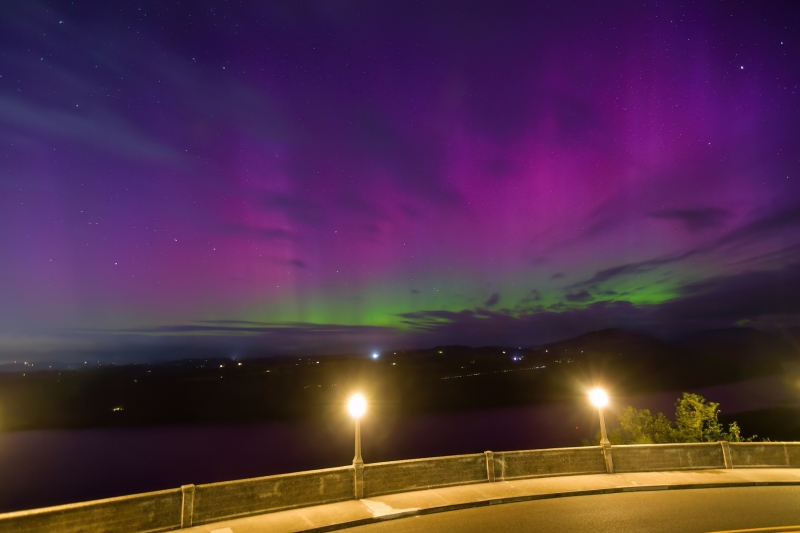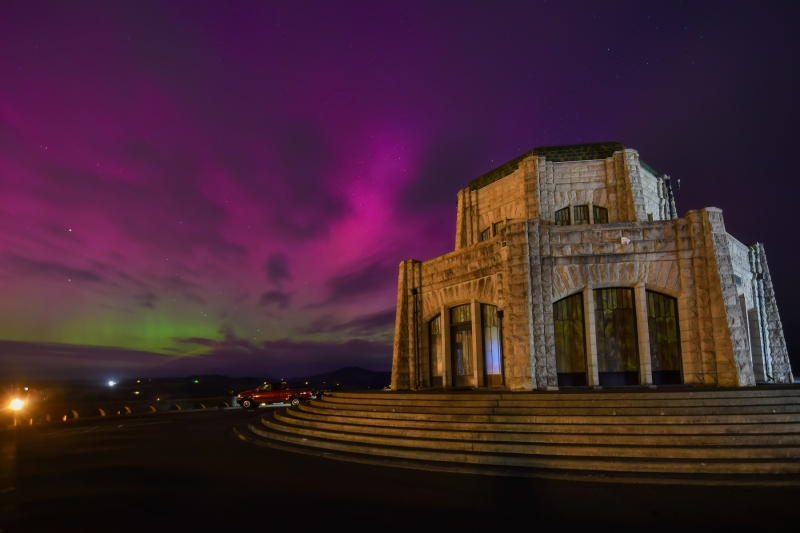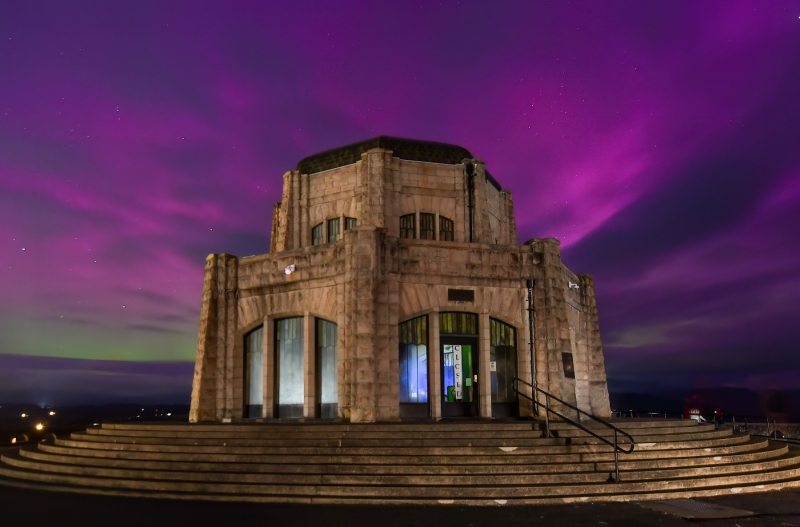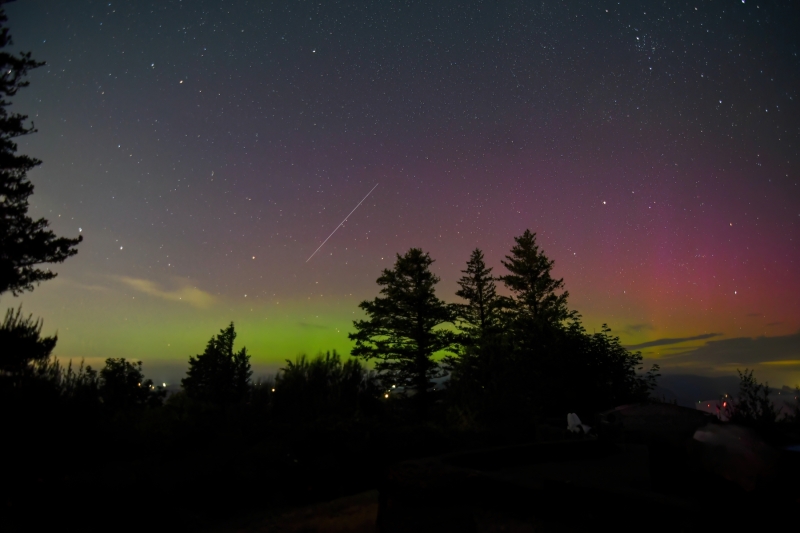The sun is at the midpoint of its 11 year long Solar Cycle 25, what is called Solar Maximum. During the Maximum sunspot activity is greatly increased, and our nearest star belches out solar flares and radiation into the cosmos more frequently and with greater intensity than at other points in the cycle. When the rotation of the Sun is just right, some of those flares are launched toward our little blue planet. These flares can have negative impacts, disrupting communications and electrical grids if they are large enough. On a more positive note, they also create especially strong aurora borealis, more commonly known as the Northern Lights. These shimmering, dancing, colorful displays are commonplace around the North Pole, but rarely show themselves as far south as Portland.
Mom saw them once when she was a little girl visiting family in Montana, but I have never seen them myself, despite having tried dozens of times throughout my adult life. We had a great chance back in May, lots of people all around Portland saw them in the wee hours of the night, but sadly we were not so lucky. That very long dry streak finally came to an end last Sunday night (technically Monday morning).
Mom heard on the news that the auroras may be visible after midnight. It also just happened to be the peak night for the Persied Meteor shower, making it a double whammy. I was very hesitant to go out at midnight, as I was tired from working on the fence all day, but I had Monday off from work for an unrelated reason, so we decided to give it a go. The first few places we tried, closer into town, netted no results and I was starting to get that old familiar feeling that many a snipe hunter has endured over the ages. Feeling disappointed but ever hopeful, we decided to go a little further east into the Gorge, hoping for a little darker skies at the Portland Women’s Forum near Corbett.
When we arrived there were maybe 15 cars or so in the lot, with small groups of people clustered together on blankets watching the skies for shooting stars. No one seemed to be interested in the Northern Lights. Just as we got parked and stepped out of the truck, a really big meteor shot across the sky, leaving a smoke trail behind it! We figured that was a good omen, so I wandered over to an area with a decent view to the north. I couldn’t see anything with my naked eye, but having spoken to lots of folks who had seen them in May, I knew that often you could not actually see the dancing colors in the sky with your naked eye like you can further north. But cameras are much more sensitive to spectrums of light that the human eye cannot see, so I snapped a few test shots with my phone. Low and behold I could see a little bit of green along the horizon!
Feeling hopeful and excited now, I got the D500 out of the truck and set up the tripod. While I was getting ready I saw a few shooting stars, and heard a number of oohs and ahhs from the crowed as meteors flashed across the night, the vast majority of which were behind my back. I took a couple of test shots, and sure enough, I was seeing some green and pink glow along the horizon! Several more shooting stars struck across the sky, one even within my frame to the north but, sadly, not while the shutter was open. (Of course!)
Still, we were seeing a lot more meteors than many of our previous attempts, so I was hopeful that we could catch one over the auroras. I consulted the PhotoPils app to determine how long I could keep my shutter open and still get nice pinprick stars instead of the beginning of trails. It said 19 seconds at 11mm focal length. My camera has settings for 15 seconds or 20 seconds. I chose 15 second exposures.
Two or three meteors shot across the northern sky in my frame, one of which was a really big one with a long tail… but always while I was reviewing photos or changing shooting angles, never while the shutter was open. Finally, after about an hour, I got lucky and managed to catch one small shooting star low over the horizon all lit up with green and pink auroras! Exactly what I was after.
It was getting late, but given that we were finally seeing the Northern Lights in person, we wanted to take full advantage so we headed down the road a bit to Vista House. As luck would have it just as we arrived at Vista House, the auroras began intensifying. We could actually just barely see them with the naked eye. They weren’t really colorful, but it did look a bit like the first glimmers of sunlight over the horizon, extending up into the sky in long, narrow fingers. I got the camera setup right in front of the truck, looking out over the winding road descending down into the Gorge, and holy cow! Instead of an indistinct glow like I’d seen over at the Women’s Forum, now we could see waves and flares of pink light arcing up into the sky over bright green!
I began moving around the Vista House, taking pictures as I went. After maybe 15-20 minutes some clouds or fog began to roll in, which began reflecting the light from the auroras, and boy did that make for a dramatic shot of what my grandad used to the call “The Million Dollar Toilet” with the Northern Lights bursting out around its dome. That was a total money shot!
I got two or three shots of that before the clouds/fog rolled in quite heavily, and the auroras faded quickly. It was getting late, around 3am now, so we decided to head home and call it a night. But boy, what an excellent adventure it was!
According to the scientists at NOAA who track this sort of thing, the sun is expected to maintain the current level of activity through at least January, and should be quite active for the entirety of 2025. So who knows… maybe we will get another chance in the not-too-distant future!




